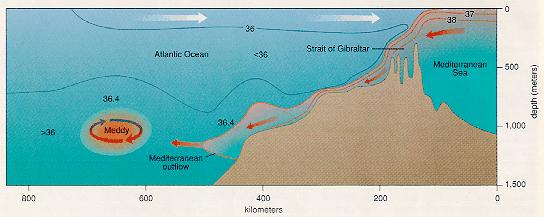Origin of Meddies


Eddies form when warm, salty Mediterranean water flows out of the Strait of
Gibraltar beneath cooler incoming water and descends along the continental
slope. At a depth of around 1000 metres, the salty and warm tongue of
Mediterranean water reaches neutral buoyancy with the surrounding ocean
water and separates from the continental slope. Pieces of this water pinch
off and drift southwestward in the Atlantic Ocean as clockwise-rotating
(=anticyclonic) lenses of salty, warm water that are called Meddies.
Blue lines in the figure are contours of constant salinity (in practical salinity units, a measure based on conductivity), and the arrows indicate general water flow.
Subsurface water in the Mediterranean is around 12 degrees Celsius and comparatively salty, at 3.8 percent. Typical Meddies are around 800 metres thick and 100 kilometers in diameter. They contain about 0.08 percent more salt than the surrounding ocean water, which corresponds to around 2 billion tons of salt per Meddy. The number of
Meddies are living quite long because rotate rapidly and translate slowly through the calm waters of the Canary Basin: they are quite stable. The number of Meddies in the Canary Basin is unknown but may be around 25 at a time.
<=== Post-doc. research in Dundee page
 Jos van Geffen --
Home |
Site Map |
Contact Me
Jos van Geffen --
Home |
Site Map |
Contact Me